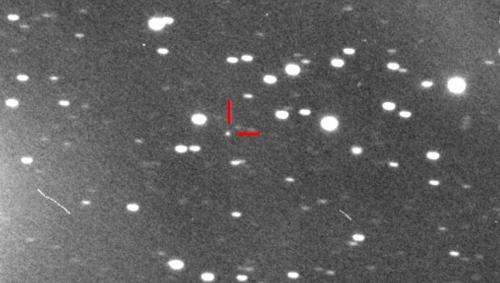January 15, 2013 report
Comet ISON shaping up to be a spectacular display

Bob Yirka
news contributor

(Â鶹ÒùÔº)—Excitement is mounting for astronomers and star gazers the world over as word spreads that Comet ISON may go down in the history books as one of the flashiest ever. First discovered in September of last year by Russian astronomers, Vitali Nevski and Artyom Novichonok, (C/2012 S1) has been drawing attention ever since.
Comets, as most are well aware, are balls of ice and rock that move though space – when they get close enough to the sun, they sprout tails giving rise to poetic descriptions of beauty by some and claims of mystical phenomenon by others. Comet ISON is expected to be at its brightest in late November of this year, leading some to link it with the Star of Bethlehem which the Bible says led the three wise men to the newborn baby Jesus. Its perihelion – closest approach to the sun – is expected to occur on November 28 and the comet will likely be best viewed in the northern hemisphere.
Of course, projecting the brilliance of a comet or its tail length is an iffy proposition to be sure. It could just break apart when it nears the sun (it's expected to come as close as 32,000 miles), leaving us here on Earth less than impressed with the results, (see Comet Kohoutek - 1973.) More optimistically, because of its size and orientation, it might just present us with the brightest comet show ever seen.
Right now Comet ISON is in Jupiter's orbit, hurtling towards a rendezvous with the sun. As it approaches, bits of it will be vaporized, leading to the creation of a tail. Once it arrives, it will whip around the sun at approximately 425,000 mph and then head back into space passing our planet on its way, allowing us to see it in all its finery.
The best viewing time for the comet is expected to be early in the morning before the sun comes up, as it approaches, and then at both pre-dawn and just after the sun sets as the comet is leaving. When it's approaching, its tail will follow behind it, but as it's leaving, due to solar wind, it will be following its own tail. Estimates on Comet ISON's brightness vary – some suggest it might be equal in luminescence to the planet Mars, while others hint that it might be as bright as the moon, which means it would be visible even during daylight hours.
Written for you by our author —this article is the result of careful human work. We rely on readers like you to keep independent science journalism alive. If this reporting matters to you, please consider a (especially monthly). You'll get an ad-free account as a thank-you.
© 2013 Â鶹ÒùÔº





















